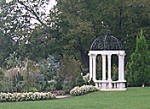
As we pass through the last weeks of August it appears that the heat and humidity will lift but in the meantime we still have more rain than the plants can handle and the brown spots in the grass have enlarged and increased in number so badly that we had to call the lawn man to spray. I hate having to do this but the alternative is a mud flat of red clay and I have lived through that before.
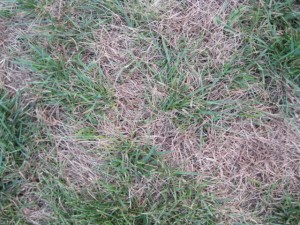
The brown spots vary in size from small to quite large.
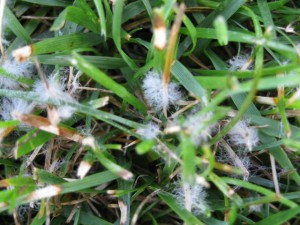
The culprit is a fungus that can be seen early in the morning as a white fuzz on the leaves. Once the sun gets up you can’t see the fungus but it does its dirty work all the same.
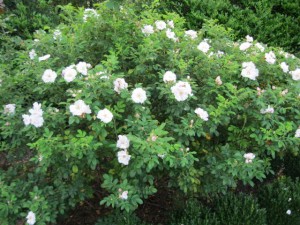
In spite of blackspot many roses are pumping out flowers. My rugosa rose, ‘Henry Hudson” has revived from its severe pruning last spring and has a nice display of flowers.
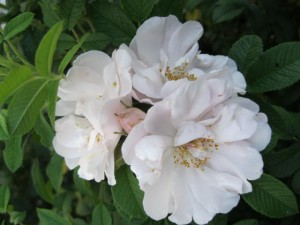
The flowers of the bush are borne in clusters; the buds are pink but open to white flowers.
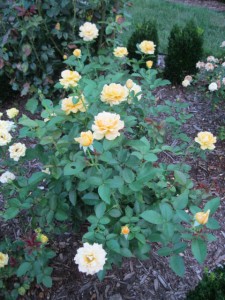
The floribunda ‘Julia Childs’ is full and bushy; a nice looking bush even when not blooming.
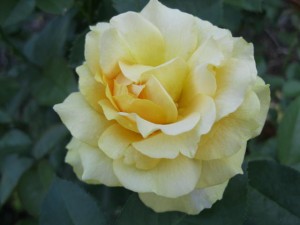
Its flowers are fragrant and a rich, buttery golden yellow color. Yumm…
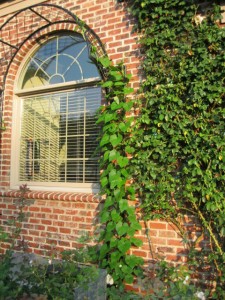
I am happy to report that the moonvine has grown so tall that I can no longer measure it. Ignore the rose growing next to it; the moonvine is only on the trellis and is a lighter green than the rose.
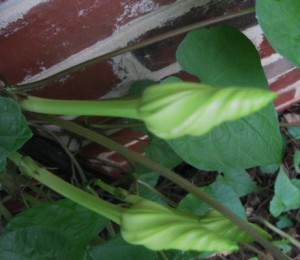
It has buds! They will unwind in the evening, an event well worth watching.
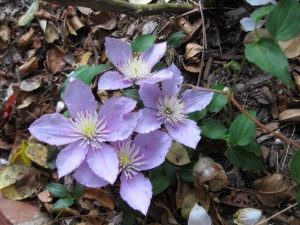
The clematis right outside the rose garden is producing a second show; the flowers are not as large as those in the spring but still very pretty and welcome.
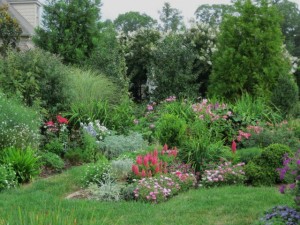
The plants in the formal garden are having their ups and downs but certain areas are blooming away and look very pretty.
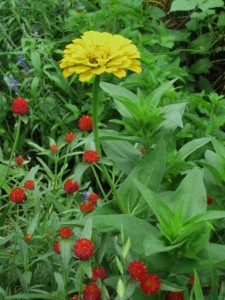
The yellow zinnias and red Geomphrena ‘Strawberryfields’ are a contrast in color, form, textures, and size.
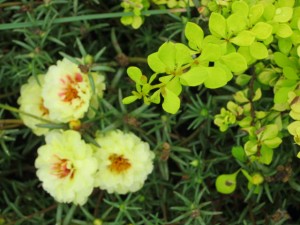
I have some a couple of yellow leaf barberries in two parterres that keep things lively with yellow portulaca.
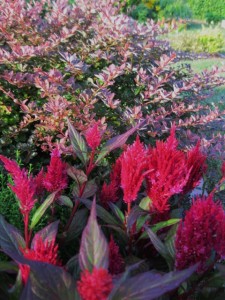
Another barberry, ‘Crimson Pigmy’ brightens forms a nice backdrop for crimson red celosia.
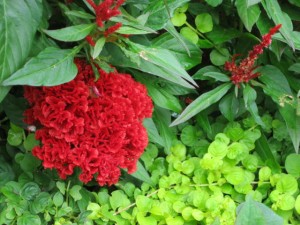
The celosia love the hot weather and are looking grand. The creeping jenny at the feet of the scarlet brain celosia really makes the colors pop.
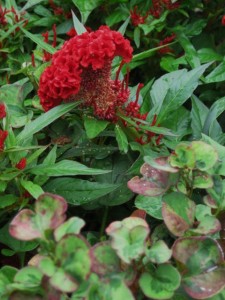
Elsewhere the red of the celosia is echoed by the red in houttuynia ‘Chameleon’.
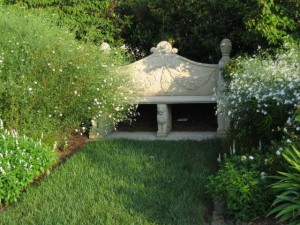
The blooming of the boltonia signals me that fall is near. I love the white flowers with the white of the stone bench.
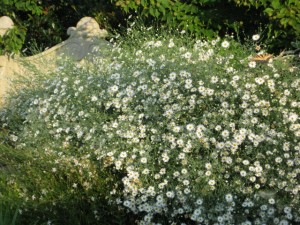
The boltonia on one side has many more flowers in bloom than that on the other. This seems to be a pattern and the Kousa dogwoods and candy tuft on either side grow quite differently too. Here is the more developed one in bloom.
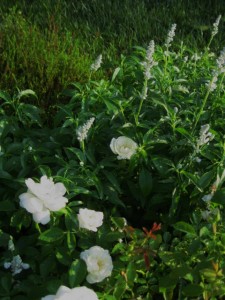
White Salvia farninacea and a white patio rose bloom in front of one of the boltonias.
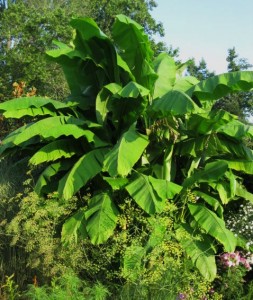
The hardy banana plant is looking as though it has been in the garden for years but all the growth that you see is from this year! We cut it way back each fall and cover it with leaves. In spring it begins growth as soon as it is uncovered and here is the result. The most delicate plant in the garden, fennel, is growing with the coarsest; quite a contrast.
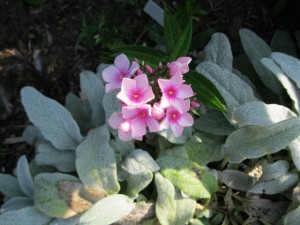
The phlox are also loving the heat and tolerating the humidity amazingly well with only some touches of mildew. My favorite phlox is ‘Bright Eyes, peaking through the lamb’s ear, one of the only clumps that has not melted out.
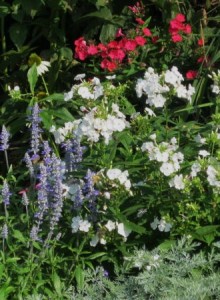
I wish I had this combination 6 weeks ago. I never noticed it before but it makes one part of the garden very patriotic looking.
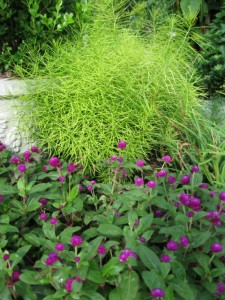
I have cut the Amsonia back twice this summer but now I am ready to enjoy its fall color which has already begun.
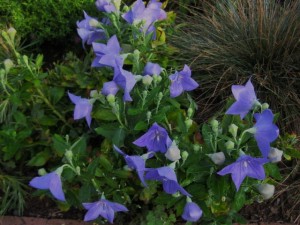
The balloon flower plants have thrived with the deadheading I have done this summer. Most of the plants have bloomed all summer through heat and humidity and are still making a wonderful show. I have never been so lucky before.
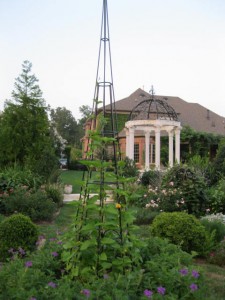
Now that my moonvine has struck its stride I am watching my black eyed Susan vines in the large container in the middle of the formal garden.
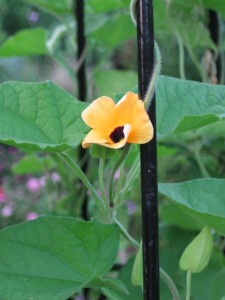
The vines have been very slow to get started but are blooming as the twin their way up the trellis.
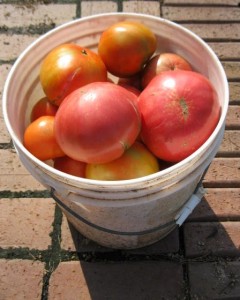
The vegetable garden is still pumping out tomatoes but they are getting smaller and rattier.
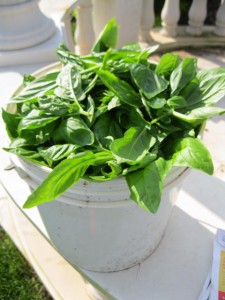
The basil, on the other hand is looking terrific and we are having a hard time using it all. I try to keep the tops picked at all times so the plants can’t produce flowers, thus maintaining the sweet licorice flavor. I think we will be having quite a bit of pesto dishes this week. Yummy!
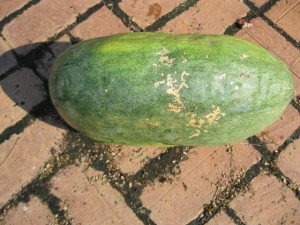
Is it a melon? It grew in an area where we grew Armenian cucumbers and musk melon last year. I think there was a bit of hanky pank there.
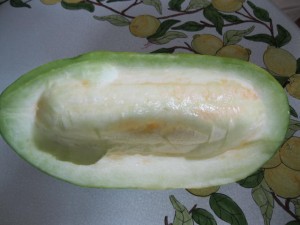
The inside looks a bit like a honeydew and tastes like an unripened honeydew with a cucumber twist.
Maybe next year I’ll get lucky and produce a new melon that tastes good.
